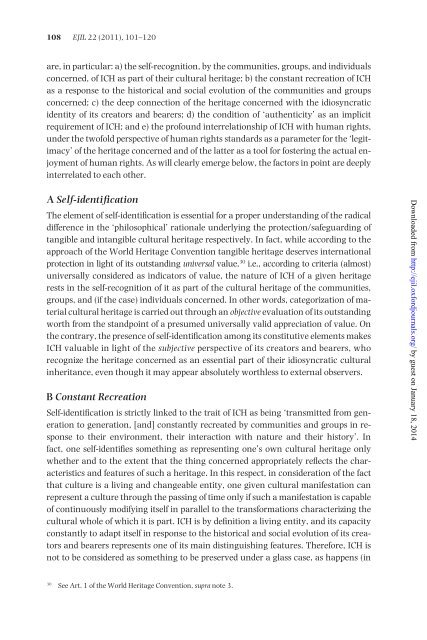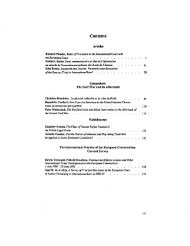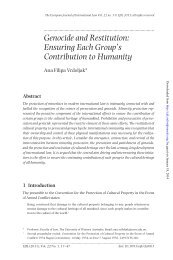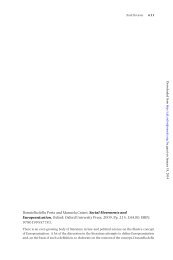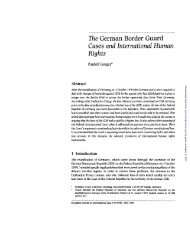Intangible Cultural Heritage - European Journal of International Law
Intangible Cultural Heritage - European Journal of International Law
Intangible Cultural Heritage - European Journal of International Law
You also want an ePaper? Increase the reach of your titles
YUMPU automatically turns print PDFs into web optimized ePapers that Google loves.
108 EJIL 22 (2011), 101–120<br />
are, in particular: a) the self-recognition, by the communities, groups, and individuals<br />
concerned, <strong>of</strong> ICH as part <strong>of</strong> their cultural heritage; b) the constant recreation <strong>of</strong> ICH<br />
as a response to the historical and social evolution <strong>of</strong> the communities and groups<br />
concerned; c) the deep connection <strong>of</strong> the heritage concerned with the idiosyncratic<br />
identity <strong>of</strong> its creators and bearers; d) the condition <strong>of</strong> ‘authenticity’ as an implicit<br />
requirement <strong>of</strong> ICH; and e) the pr<strong>of</strong>ound interrelationship <strong>of</strong> ICH with human rights,<br />
under the tw<strong>of</strong>old perspective <strong>of</strong> human rights standards as a parameter for the ‘legitimacy’<br />
<strong>of</strong> the heritage concerned and <strong>of</strong> the latter as a tool for fostering the actual enjoyment<br />
<strong>of</strong> human rights. As will clearly emerge below, the factors in point are deeply<br />
interrelated to each other.<br />
A Self-identification<br />
The element <strong>of</strong> self-identification is essential for a proper understanding <strong>of</strong> the radical<br />
difference in the ‘philosophical’ rationale underlying the protection/safeguarding <strong>of</strong><br />
tangible and intangible cultural heritage respectively. In fact, while according to the<br />
approach <strong>of</strong> the World <strong>Heritage</strong> Convention tangible heritage deserves international<br />
protection in light <strong>of</strong> its outstanding universal value, 30 i.e., according to criteria (almost)<br />
universally considered as indicators <strong>of</strong> value, the nature <strong>of</strong> ICH <strong>of</strong> a given heritage<br />
rests in the self-recognition <strong>of</strong> it as part <strong>of</strong> the cultural heritage <strong>of</strong> the communities,<br />
groups, and (if the case) individuals concerned. In other words, categorization <strong>of</strong> material<br />
cultural heritage is carried out through an objective evaluation <strong>of</strong> its outstanding<br />
worth from the standpoint <strong>of</strong> a presumed universally valid appreciation <strong>of</strong> value. On<br />
the contrary, the presence <strong>of</strong> self-identification among its constitutive elements makes<br />
ICH valuable in light <strong>of</strong> the subjective perspective <strong>of</strong> its creators and bearers, who<br />
recognize the heritage concerned as an essential part <strong>of</strong> their idiosyncratic cultural<br />
inheritance, even though it may appear absolutely worthless to external observers.<br />
B Constant Recreation<br />
Self-identification is strictly linked to the trait <strong>of</strong> ICH as being ‘transmitted from generation<br />
to generation, [and] constantly recreated by communities and groups in response<br />
to their environment, their interaction with nature and their history’. In<br />
fact, one self-identifies something as representing one’s own cultural heritage only<br />
whether and to the extent that the thing concerned appropriately reflects the characteristics<br />
and features <strong>of</strong> such a heritage. In this respect, in consideration <strong>of</strong> the fact<br />
that culture is a living and changeable entity, one given cultural manifestation can<br />
represent a culture through the passing <strong>of</strong> time only if such a manifestation is capable<br />
<strong>of</strong> continuously modifying itself in parallel to the transformations characterizing the<br />
cultural whole <strong>of</strong> which it is part. ICH is by definition a living entity, and its capacity<br />
constantly to adapt itself in response to the historical and social evolution <strong>of</strong> its creators<br />
and bearers represents one <strong>of</strong> its main distinguishing features. Therefore, ICH is<br />
not to be considered as something to be preserved under a glass case, as happens (in<br />
Downloaded from http://ejil.oxfordjournals.org/ by guest on January 18, 2014<br />
30<br />
See Art. 1 <strong>of</strong> the World <strong>Heritage</strong> Convention, supra note 3.


